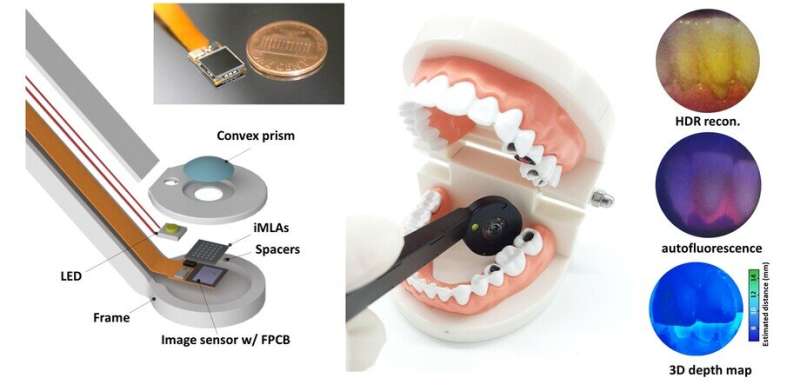Ultrathin dental camera inspired by insect-eye structure

Conventional dental photography technology has had a limitation in using inconvenient tools such as mirrors and cheek retractors. Dentists require basic teeth images from various angles, such as right/left buccal and maxillary/mandibular occlusal, for dental health inspection. To acquire these images, patients feel discomfort because dentists must put a mirror into the mouth to capture the reflected teeth image through a handheld camera.
A compact intraoral dental camera can overcome the discomfort and scan the condition of teeth. However, due to the restricted depth of field and field-of-view, the conventional device has limitations in close-up imaging for observing tooth decay in detail and wide-angle imaging for capturing the entire arrangement of teeth.
Various species of compound insect eyes have superior visual characteristics, such as wide viewing angle and large depth of field with compact visual organs made up of tiny lenses. Insect eyes give inspiration for miniaturized cameras, and insect-inspired cameras can solve the problems of conventional compact cameras, such as limited observation range. However, previously developed insect cameras have drawbacks in low-resolution or limited functions.
As reported in the Journal of Optical Microsystems, researchers from Korea Advanced Institute of Science and Technology and Korea Photonics Technology Institute recently developed a novel wide-angle insect eye camera, the biologically inspired intraoral camera (BIOC), for assorted functional imaging. Using the device, assorted functional imaging was demonstrated to satisfy clinical needs.
The BIOC involves a new configuration of convex-concave lens and inverted microlens arrays (iMLA) and a single CMOS image sensor on a flexible printed circuit board in a handpiece holder. The convex-concave lens substantially increases the field of view up to 143 degrees, and iMLAs reduce optical aberration by the scaling law. In addition, the new camera overcomes many chronic issues of conventional intraoral cameras, such as limited depth-of-field, thick total-track-length, and limited functional imaging.

The ultrathin dental camera can solve discomfort states owing to its thinness and observe teeth even in anatomically narrow regions. Also, clear dental imaging is achieved without image blur by emulating the insect vision feature of infinite depth of field even at close object distance. The BIOC offers multifunctional dental imaging, such as high dynamic range, 3D depth, and autofluorescence imaging, through the multichannel vision system.
The authors hope that the novel wide-angle insect eye camera contributes not only to technical advances in biomedical engineering societies but that it also has significant impacts on such diverse vision applications as surveillance, smartphone, and drones. They anticipate a continuing expansion in applications in the future.
Researchers create miniature wide-angle camera with flat metalenses
Kisoo Kim et al, Biologically inspired intraoral camera for multifunctional dental imaging, Journal of Optical Microsystems (2022). DOI: 10.1117/1.JOM.2.3.031202
Citation:
Ultrathin dental camera inspired by insect-eye structure (2022, August 19)
retrieved 19 August 2022
from https://phys.org/news/2022-08-ultrathin-dental-camera-insect-eye.html
This document is subject to copyright. Apart from any fair dealing for the purpose of private study or research, no
part may be reproduced without the written permission. The content is provided for information purposes only.
For all the latest Science News Click Here
For the latest news and updates, follow us on Google News.

